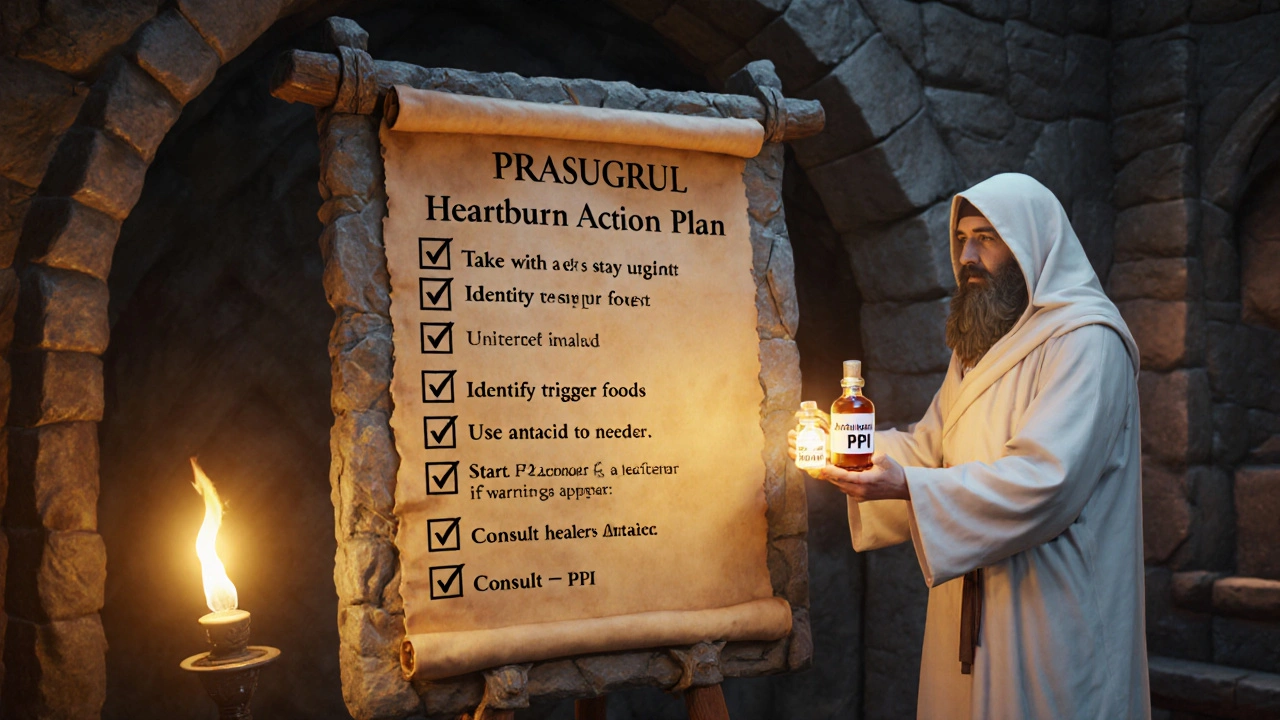Prasugrel Heartburn Risk Calculator
Heartburn Assessment
Answer the following questions to determine your heartburn risk level while taking Prasugrel.
Feeling that burning sensation after a meal while taking Prasugrel heartburn can be frustrating, especially when you’re already on a heart‑protecting regimen. This guide walks you through why the medication can trigger heartburn, what you can do right now to calm it, and when it’s time to ask your doctor for a tweak.
What is Prasugrel?
Prasugrel is a thienopyridine antiplatelet drug that blocks the P2Y12 receptor on platelets, preventing them from clumping together. It’s commonly prescribed after a PCI (percutaneous coronary intervention) or an acute coronary syndrome to lower the risk of another heart attack.
Because it works by keeping platelets from forming clots, doctors often pair it with aspirin for a dual‑antiplatelet therapy (DAPT). While the cardiovascular benefits are clear, a few patients notice gastrointestinal discomfort, most often in the form of heartburn.
Why Can Prasugrel Trigger Heartburn?
Prasugrel itself doesn’t directly irritate the esophagus, but there are a few mechanisms that can raise the odds of heartburn:
- Platelet inhibition and stomach lining: Reduced platelet function can affect the protective mucus layer in the stomach, making it more vulnerable to acid.
- Concurrent aspirin use: Aspirin is a known irritant; when combined with prasugrel, the risk of acid‑related symptoms can climb.
- Co‑medications: Some patients also take statins, beta‑blockers, or ACE inhibitors, which can interact with the gut’s motility and acid production.
Understanding these pathways helps you target the right remedy rather than just masking the pain.
Quick Ways to Ease the Burn
- Take the pill with food. A small, low‑fat snack can buffer stomach acid and reduce direct irritation.
- Stay upright for at least 30minutes after dosing. Gravity keeps stomach contents from pushing up into the esophagus.
- Chew an antacid tablet (e.g., calcium carbonate) if the burn is sudden. It works within minutes and can be a stop‑gap while you adjust longer‑term strategies.
If you find yourself reaching for the antacid more than a couple of times a week, it’s time to look deeper.
Lifestyle Tweaks That Make a Difference
Simple habit changes often outshine medication swaps.
- Meal timing: Avoid large meals or spicy, fatty foods at least two hours before bedtime.
- Hydration: Sip water throughout the day, but limit large volumes right after taking prasugrel.
- Weight management: Even a modest reduction can lower abdominal pressure that forces acid upward.
- Smoking & alcohol: Both relax the lower esophageal sphincter, increasing reflux risk. Cutting back can dramatically cut heartburn frequency.
These steps are low‑cost, low‑risk, and often produce noticeable relief within a week.
When to Call Your Healthcare Provider
Heartburn is usually manageable, but certain signs mean you should seek professional advice:
- Chest pain that mimics angina or feels like pressure rather than a burning sensation.
- Difficulty swallowing, persistent sour taste, or regurgitation of food.
- Bleeding signs - black stools, vomiting blood, or unexplained anemia.
- Heartburn that interferes with sleep or daily activities despite lifestyle changes.
Doctors might adjust the aspirin dose, add a protective medication, or, in rare cases, switch to an alternative antiplatelet such as clopidogrel.

Antacid vs. Proton Pump Inhibitor: Which Works Best for Prasugrel‑Related Heartburn?
| Medication Type | Onset of Relief | Duration | Interaction Risk with Prasugrel | Typical Use |
|---|---|---|---|---|
| Antacid (e.g., calcium carbonate) | 5‑10minutes | 1‑2hours | Low | As‑needed, occasional |
| H2‑blocker (e.g., ranitidine‑free famotidine) | 30‑60minutes | 4‑6hours | Low‑moderate (can affect absorption of some drugs) | Twice daily for moderate symptoms |
| Proton Pump Inhibitor (e.g., omeprazole) | 1‑2hours | 24‑48hours | Moderate (may reduce efficacy of clopidogrel, but minimal with prasugrel) | Once daily, usually for chronic reflux |
Because prasugrel’s activation isn’t heavily reliant on gastric pH, a PPI is generally safe, but always run it past your prescriber if you’re on multiple meds.
Putting It All Together: A Simple Action Plan
- Take prasugrel with a small snack and stay upright.
- Identify trigger foods and eat earlier in the evening.
- Use an antacid for occasional flare‑ups.
- If heartburn persists >3days, start an H2‑blocker for a week.
- Consult your doctor if symptoms remain or you notice warning signs.
This step‑by‑step routine lets you stay on the heart‑protective therapy while keeping the burn at bay.
Frequently Asked Questions
Can I take over‑the‑counter antacids with prasugrel?
Yes, most calcium‑based antacids are safe with prasugrel. They work locally in the stomach and don’t affect platelet function. Just avoid taking them at the exact same minute as your prasugrel dose; a 30‑minute gap is enough.
Why does aspirin increase my heartburn risk while on prasugrel?
Aspirin irritates the stomach lining and can reduce the protective mucus layer. When you combine it with prasugrel, the overall protection against ulceration is lowered, making acid‑related symptoms more likely.
Should I switch to clopidogrel if heartburn keeps coming back?
Clopidogrel has a similar antiplatelet effect but a different activation pathway. It can be an option, but the decision depends on your cardiac risk profile. Talk to your cardiologist before making any swap.
Is it safe to use a proton pump inhibitor long term?
Long‑term PPI use is generally safe for most adults, though some studies link it to low‑grade nutrient deficiencies. Because prasugrel doesn’t rely on stomach acidity, a PPI can be continued if you need strong reflux control, but periodic review with your doctor is wise.
What lifestyle changes have the biggest impact?
Eating smaller meals, avoiding late‑night snacks, and staying upright after doses cut the reflux trigger in half for most people. Adding a short walk (10‑15minutes) after meals also helps gastric emptying.

Amanda Joseph
September 15, 2025 AT 21:40Wow, another heartburn saga-definately the most thrilling side effect of life‑saving meds.
Kevin Aniston
September 23, 2025 AT 11:40First off, thanks for putting together such a thorough rundown on prasugrel‑related heartburn. I appreciate the clear breakdown of why the medication can tip the acid balance, especially the point about platelet inhibition affecting the mucosal barrier. The inclusion of the risk calculator is a clever interactive touch that helps patients gauge their own situation. Your step‑by‑step action plan feels like a practical roadmap rather than vague advice. I also like that you distinguished between antacids, H2‑blockers, and PPIs, noting the specific interaction profiles. The recommendation to separate antacids by 30 minutes from the dose is spot‑on and often overlooked. Encouraging patients to stay upright after dosing is a simple yet effective maneuver that many forget. The lifestyle tweaks you listed-smaller meals, avoiding late‑night snacks, weight management-are evidence‑based and realistic. I was pleased to see the emphasis on smoking and alcohol reduction as a means to protect the lower esophageal sphincter. Your warning signs section is crucial; distinguishing chest pain from heartburn can be life‑saving. It’s also helpful that you addressed the potential need to switch to clopidogrel under certain circumstances. The table comparing antacids, H2‑blockers, and PPIs is a handy quick‑reference for both patients and clinicians. I particularly liked the balanced tone that neither scares patients nor downplays the seriousness. Overall, this guide equips readers with actionable steps while maintaining the necessary medical vigilance. Keep up the excellent work; resources like this bridge the gap between prescription and everyday comfort.
kiran kumar
October 1, 2025 AT 01:40i dont see the point of all that hype if the real fix is just stop taking prasugrel and grab a soda
Brian Johnson
October 8, 2025 AT 15:40I find the recommendation to take the pill with a light snack especially practical. It’s a low‑effort habit that can significantly reduce irritation. Staying upright for half an hour also aligns with gastro‑esophageal physiology, so the advice is sound.
Shouvik Mukherjee
October 16, 2025 AT 05:40Absolutely, incorporating a short post‑meal walk can further aid gastric emptying and complement the upright position. It’s a gentle addition that respects diverse routines while still delivering benefit.
Ben Hooper
October 23, 2025 AT 19:40Antacids work fast but only for occasional flare ups they don’t replace a proper regimen
Marjory Beatriz Barbosa Honório
October 31, 2025 AT 08:40Love that you highlighted the “small snack” trick – it’s like giving your stomach a tiny cushion before the medication storm hits. Adding a splash of almond milk or a banana can be both tasty and soothing. Remember, the goal is consistency, not perfection, so keep experimenting until you find your sweet spot.
G.Pritiranjan Das
November 7, 2025 AT 22:40Small changes, big relief – keep at it.
Karen Wolsey
November 15, 2025 AT 12:40Oh great, another reminder to “stay upright” like I haven’t been bending over my laptop for years. But seriously, that tip does help keep the acid down where it belongs.
Trinity 13
November 23, 2025 AT 02:40When we consider the interplay between pharmacology and the human body, we are reminded that medicine is not merely a set of chemical reactions but a dialogue between intent and physiology. Prasugrel, in its noble quest to prevent clots, inadvertently nudges the gastric environment toward acidity, a subtle push that can manifest as heartburn. This paradox underscores the humility required of both prescriber and patient, recognizing that every therapeutic gain carries a potential cost. Lifestyle modifications, such as mindful eating and posture, emerge as the non‑pharmacologic chorus that balances this equation. They are not merely ancillary suggestions but integral components of a holistic regimen. By aligning daily habits with the body’s circadian rhythm, we can mitigate the erosive fire that occasional acid brings. Moreover, the decision to incorporate an H2‑blocker or a PPI should be viewed through the lens of personalized medicine, weighing benefit against possible long‑term nutrient absorption concerns. The narrative of heartburn thus becomes a microcosm of the larger medical journey: a constant negotiation between benefit, risk, and quality of life. In sharing these insights, we empower individuals to become active participants rather than passive recipients. Ultimately, the goal remains the same – a heart protected from clot while the stomach stays calm, a balance achievable through informed choices and compassionate care.
Rhiane Heslop
November 30, 2025 AT 16:40patriotism in health means we prioritize proven meds not foreign gimmicks
Dorothy Ng
December 8, 2025 AT 06:40The guide balances clinical detail with practical advice well
Justin Elms
December 15, 2025 AT 20:40Glad you found the guide useful! If you need more tips on timing doses or choosing an antacid, just let me know. I can also share simple charts for tracking symptoms.